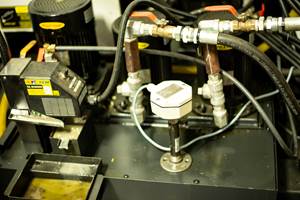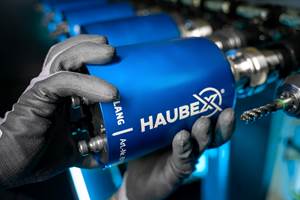Flexible Automation Takes Over Piston Machining
This manufacturer of power garden equipment implemented a flexible transfer line and found it cost significantly less than one third the price of a traditional line.
Share




Flexible, modular automation versus a traditional dial-index machine: it's a revealing test of new ideas against proven, productive automation, and Homelite, Inc. has provided an excellent example to evaluate the state of automation engineering. The well-known manufacturer of power garden equipment—chainsaws, weed-whackers and blowers—opted in 1996 to replace their piston-machining system, a six-spindle dial-index machine, with a system of re-configurable modules from Wasino Corp. USA (Wayne, New Jersey).
The flexible transfer line (FTL) consists of two high-precision CNC chuckers and one CNC boring machine. Each machine has its own integral gantry loader and each loader is controlled by the Fanuc CNC on its respective machine tool. The system is completely asynchronous: in other words, programming, loading and unloading is independent and self-contained within each machine/gantry combination. Coordination and parts hand-offs between machines doesn't require a separate line-controlling computer or sequencer. The gantry of one machine unloads parts to a staging module that, where the application demands it, can flip or re-orient the part for pickup by the next machine, after a "part-present" signal is sent to the next CNC that the part is ready and waiting.
The FTL usually is simpler than a traditional transfer line in its mechanics and simpler than synchronous CNC in its control. As flexible automation has evolved the asynchronous approach has proven to be generally superior to synchronous control because it permits fast and easy reconfiguration of the line, allowing a machine to be added or removed with minimal complication. The flip side of the coin is that it allows a new transfer line to be installed and placed in operation in the shortest possible time—a small fraction of the time required to get traditional automation online and productive—while it also allows production to be "ramped up" in stages rather than committing to a high-volume line in a single, all-or-nothing step. The ability to reconfigure the line quickly was one advantage that appealed to Homelite. They already have one change planned, a new development from Wasino that machines elliptical piston skirts under CNC. It's a camless, all-electronic system called "Pulse-Turn", which turns elliptical skirts with as little as 0.001-inch difference between major and minor diameter, at speeds up to 6,000 rpm. Thanks to new EPA regulations, even the smallest engines will require the sophistication of elliptical piston skirts in the near future, to help meet new pollution-control requirements.
Step-by step, parts go through this sequence: The first machine's gantry loader picks up a piston casting from the material feeder and loads it into an orientation station. The casting is oriented by sensing the location of its wrist-pin cavity. The same gantry loader then loads the part into the first machine, where it's chucked by the skirt; the dome and grooves are then turned. Once again, the part is picked up by the first gantry loader, which unloads it onto a staging- and reversing module.
The next chucker's gantry loader picks up the reversed part and loads it in the second machine, where the skirt is turned. Thin-walled and prone to distortion, the skirts are machined in two passes. The second "spring-back" pass produces an oil-retaining finish of 40-60 microinches Ra and dimensional tolerance of ±0.0005 inch (at 1.33 cpk in production; 1.67 cpk for qualification). The machine's gantry loader picks up the finished part and deposits it on a station similar to the first one. A third gantry picks up the part and loads it onto a CNC boring machine.
Wrist pin bores are machined at this third machine using an X-Y-Z boring tool and an adjustable finishing reamer. The reamer is polycrystalline diamond (PCD). Tolerances are 0.0003 inch TIR for size and ±0.00015 inch for roundness, with a 16 microinch Ra surface finish. The part is then marked and unloaded, complete in 32 seconds.
Homelite's per-part cycle time on dial-index machines was 12 seconds. The new line, made up of flexible modules, isn't as fast in itself but this line cost significantly less than one third the price of a traditional line. The economics are comparable on a simple investment/production basis but the other advantages swing the economics strongly in the FTL's favor.
Flexible automation is driven primarily by competitive pressure to adapt quickly to change. The FTL, an asynchronous line of high-accuracy machines with straight-line gantry loading, has proven its effectiveness in Homelite's demanding, high-volume production application. MMS
Related Content
Managing Coolant with Skimmers, Refractometers and More
Bacteria-infected coolant harms machines and sickens machinists. Coolant management technologies like skimmers and automated systems counter this tendency.
Read MoreCNC Machine Shop Honored for Automation, Machine Monitoring
From cobots to machine monitoring, this Top Shop honoree shows that machining technology is about more than the machine tool.
Read MoreUsing the Toolchanger to Automate Production
Taking advantage of a feature that’s already on the machine tool, Lang’s Haubex system uses the toolchanger to move and store parts, making it an easy-to-use and cost-effective automation solution.
Read MoreInside the Premium Machine Shop Making Fasteners
AMPG can’t help but take risks — its management doesn’t know how to run machines. But these risks have enabled it to become a runaway success in its market.
Read MoreRead Next
5 Rules of Thumb for Buying CNC Machine Tools
Use these tips to carefully plan your machine tool purchases and to avoid regretting your decision later.
Read MoreSetting Up the Building Blocks for a Digital Factory
Woodward Inc. spent over a year developing an API to connect machines to its digital factory. Caron Engineering’s MiConnect has cut most of this process while also granting the shop greater access to machine information.
Read MoreBuilding Out a Foundation for Student Machinists
Autodesk and Haas have teamed up to produce an introductory course for students that covers the basics of CAD, CAM and CNC while providing them with a portfolio part.
Read More
























.jpg;maxWidth=300;quality=90)









